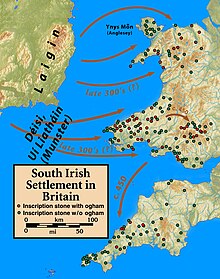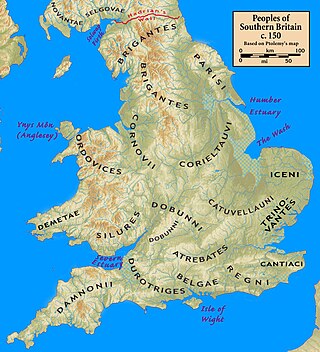
The Dumnonii or Dumnones were a British tribe who inhabited Dumnonia, the area now known as Cornwall and Devon in the further parts of the South West peninsula of Britain, from at least the Iron Age up to the early Saxon period. They were bordered to the east by the Durotriges tribe.
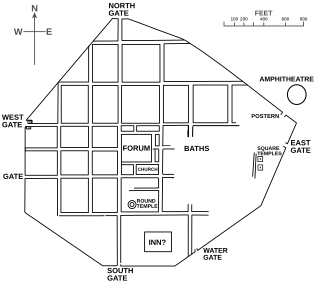
Calleva Atrebatum was an Iron Age oppidum, the capital of the Atrebates tribe. It then became a walled town in the Roman province of Britannia, at a major crossroads of the roads of southern Britain.
Dumnonia is the Latinised name for a Brythonic kingdom that existed in Sub-Roman Britain between the late 4th and late 8th centuries CE in the more westerly parts of present-day South West England. It was centred in the area of modern Devon, but also included modern Cornwall and part of Somerset, with its eastern boundary changing over time as the gradual westward expansion of the neighbouring Anglo-Saxon kingdom of Wessex encroached on its territory. The spelling Damnonia is sometimes encountered, but that spelling is also used for the land of the Damnonii, later part of the Kingdom of Strathclyde, in present-day southern Scotland. The form Domnonia also occurs. The name of the kingdom shares a linguistic relationship with the Breton region of Domnonée.

Dura-Europos was a Hellenistic, Parthian, and Roman border city built on an escarpment 90 metres above the southwestern bank of the Euphrates river. It is located near the village of Salhiyé, in present-day Syria. Dura-Europos was founded around 300 BC by Seleucus I Nicator, who founded the Seleucid Empire as one of the Diadochi of Alexander the Great. In 113 BC, Parthians conquered the city, and held it, with one brief Roman intermission, until 165 AD. Under Parthian rule, it became an important provincial administrative centre. The Romans decisively captured Dura-Europos in 165 AD and greatly enlarged it as their easternmost stronghold in Mesopotamia, until it was captured by the Sasanian Empire after a siege in 256–257 AD. Its population was deported, and the abandoned city eventually became covered by sand and mud and disappeared from sight.

Ogham is an Early Medieval alphabet used primarily to write the early Irish language, and later the Old Irish language. There are roughly 400 surviving orthodox inscriptions on stone monuments throughout Ireland and western Britain, the bulk of which are in southern Munster. The largest number outside Ireland are in Pembrokeshire, Wales.
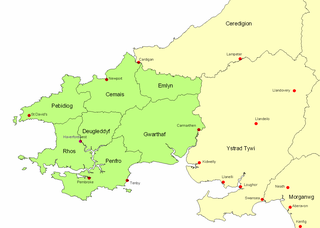
Vortiporius or Vortipor was a king of Dyfed in the early to mid-6th century. He ruled over an area approximately corresponding to modern Pembrokeshire, and Carmarthenshire, Wales. Records from this era are scant, and virtually nothing is known of him or his kingdom. The only contemporary information about Vortiporius comes from the Welsh ecclesiastic Gildas, in a highly allegorical condemnation from his De Excidio et Conquestu Britanniae. At the time the work was written, Gildas says that Vortiporius was king of Dyfed, that he was grey with age, that his wife had died, and that he had at least one daughter.

Silchester is a village and civil parish about 5 miles (8 km) north of Basingstoke in Hampshire. It is adjacent to the county boundary with Berkshire and about 9 miles (14 km) south-west of Reading.

Reading Museum is a museum of the history of the town of Reading, in the English county of Berkshire, and the surrounding area. It is accommodated within Reading Town Hall, and contains galleries describing the history of Reading and its related industries, a gallery of artefacts discovered during the excavations of Calleva Atrebatum, a copy of the Bayeux Tapestry, finds relating to Reading Abbey and an art collection.
Michael Gordon Fulford, is a British archaeologist and academic, specialising in the British Iron Age, Roman Britain and landscape archaeology. He has been Professor of Archaeology at the University of Reading since 1993.
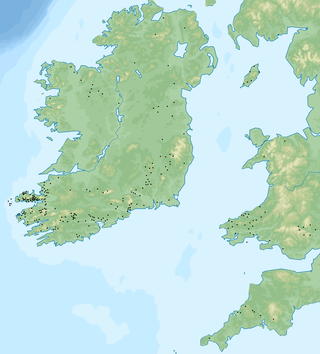
Roughly 400 inscriptions in the ogham alphabet are known from stone monuments scattered around the Irish Sea, the bulk of them dating to the fifth and sixth centuries. The language of these inscriptions is predominantly Primitive Irish, but a few examples are fragments of the Pictish language. Ogham itself is an Early Medieval form of alphabet or cipher, sometimes also known as the "Celtic Tree Alphabet".
The Knock y Doonee Ogham Stone is an early medieval memorial stone with inscriptions carved in Latin and Ogham.

Aileen Mary Fox, Lady Fox, was an English archaeologist, who specialised in the archaeology of south-west England. She notably excavated the Roman legionary fortress in Exeter, Devon, after the Second World War.
Antony Charles Thomas, was a British historian and archaeologist who was Professor of Cornish Studies at Exeter University, and the first Director of the Institute of Cornish Studies, from 1971 until his retirement in 1991. He was recognised as a Bard of the Cornish Gorseth with the name Gwas Godhyan in 1953.

Celtic inscribed stones are stone monuments dating from 400 to 1000 AD which have inscriptions in Celtic or Latin text. These can be written in Ogham or Roman letters. Some stones have both Ogham and Roman inscriptions. The stones are found in Ireland, Scotland, Wales, Brittany, the Isle of Man, and parts of western England. Most seem to be grave-markers or memorials to a dead individual.
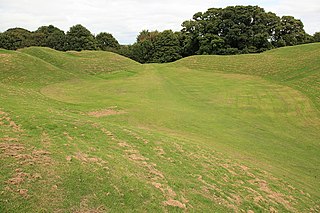
Cirencester Amphitheatre was a Roman amphitheatre in Cirencester, Gloucestershire, England. Its remains are scheduled as an ancient monument.

Katherine S. Forsyth is a Scottish historian who specializes in the history and culture of Celtic-speaking peoples during the 1st millennium AD, in particular the Picts. She is currently a professor in Celtic and Gaelic at the University of Glasgow in Scotland. She graduated from the University of Cambridge and Harvard University.

Margam Stones Museum is a small Victorian schoolhouse near Port Talbot, South Wales, which now provides a home for one of the most important collections of Celtic stone crosses in Britain. All originally found within the locality of Margam, and mostly assembled as a collection in the 19th century, they provide enduring testimony to a Welsh Christian culture between the 6th and 16th centuries. The striking Cross of Conbelin is the most celebrated example. From around 1000 AD, it is a huge disc cross with Celtic interlace and plaitwork patterns, figurative scenes including a hunting scene, and inscriptions telling us who made it and who erected it. There are 17 early Christian stones, plus 11 memorials and other stones from the post-Norman periods. The museum is run by Cadw, the Welsh historic sites agency, and is close to Margam Abbey Church and the ruins of the Abbey buildings.

The Silchester eagle is a Roman bronze casting dating from the first or second century CE, uncovered in 1866 at Calleva Atrebatum in Silchester, Hampshire, England. It was purchased in 1980 by Reading Museum in Berkshire where it remains on display as of 2024.
Cloghanecarhan is a ringfort and ogham stone forming a National Monument located in County Kerry, Ireland.
Nina Crummy is a British archaeologist and artefact specialist, especially of Roman material culture.

